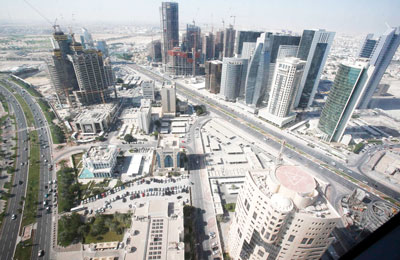
Qatar's real GDP grows 6.2pc in 2012
Doha, April 9, 2013
Qatar's real GDP grew 6.2 per cent from the earlier forecast 5.6 per cent on the back of strong non-oil and gas exports supported by expenditure in public administration, healthcare and education, said a report.
A pick up in project activity in the second half of 2012 boosted both construction and transport and communication. These sectors grew at 10.6 per cent and 12.1 per cent respectively in 2012, according to the report by Qatar National Bank (QNB) Group.
With the strong government capital spending increases, they are likely to see continued growth in 2013-14, it stated.
The country's real GDP was 0.4 per cent points stronger than the projection from QNB Group.
The non-oil and gas sector was the main driver of growth in 2012, as QNB Group had expected, expanding by 10 per cent. The share of the non-oil and gas sector in the overall economy increased to 42.2 per cent in 2012 from 40.7 per cent in 2011.
Growth in the oil and gas sector was just 1.7 per cent as an increase in gas production to supply the new Pearl Gas-to-Liquids (GTL) facility more than offset declining crude oil production.
The same project helped drive strong growth of 11.8 per cent in the manufacturing sector. Manufacturing was also supported by a ramp up in production of petrochemicals and fertilisers at new facilities, said the QNB report.
Strong growth in government services of 11.5 per cent in 2012 was another important factor driving growth, supported by expenditure in public administration, healthcare and education.
This trend is likely to continue with the recent 2013/14 budget announcement including 21 per cent higher capital spending and 16 per cent higher current spending than in the 2012/13 budget, the top Qatar lender stated.
Financial services achieved a strong growth rate of 6.7 per cent, although this is slower than in the rest of the non-oil and gas economy. With some major new road, rail and other project phases likely to be initiated in 2013-14, financial services should receive a positive boost going forward.
The trade, restaurants and hotels sector grew by 7.7 per cent in 2012, driven by population growth. The average annual increase in the number of people in Qatar was 6 per cent in 2012, the report added.
The year-on-year increase has accelerated to an average of 8.5 per cent so far in 2013, which should provide further impetus to this sector. Government efforts to promote Qatar as a destination for conferences have also helped boost this sector. Of particular note was the 18th UN Climate Change Conference in Doha in December 2012.
According to QNB Group, strong real growth in the non-oil sector is a positive indication for government plans to diversify the economy.
Overall, exports increased 16 per cent to $133 billion in 2012. The bulk of the increase came from exports of liquefied natural gas (LNG), which accounts for around 40 per cent of oil and gas exports. Production of LNG was close to full capacity in 2011 and remained level in 2012.
"Therefore, the increase in export earnings from LNG was mainly due to higher prices. Benchmark Japanese LNG prices were 14 per cent higher in 2012 than in 2011 and EU prices were 9.1 per cent higher. Exports of crude oil fell by 1.1 per cent in 2012 as production dropped while prices remained largely unchanged," said the QNB report.
The Qatari lender stated that non-oil exports grew strongly last year. "The recently completed manufacturing facilities in petrochemicals, metals and fertiliser sectors helped to boost production and exports. This is a further indication that efforts to diversify economy are gaining some traction."
Having fallen since 2008, Qatar’s imports picked up by 17 per cent in 2012, the report stated.
Typically, around half of imports over the last five years have been machinery and transport equipment related to major projects in Qatar.
According to the report, the completion of all new LNG production facilities by early 2011 played a large role in the slowdown of imports during 2008-11.
The reversal of this trend in 2012 is an indication that project activity is again beginning to pick up with the roll out of major infrastructure projects, such as the metro, roads and real estate developments,said the QNB in its report.
According to QNB Group, the strong revenue stream from the oil and gas sector will support an expansive government expenditure outlay for infrastructure development going forward, as demonstrated by the large increase in expenditures in the 2013/14 budget.
An ongoing focus on the roll out of projects in the run up to the 2022 World Cup and growing momentum in the manufacturing sector will continue to drive diversification and growth of the non-oil sector. Overall, we expect a pick up in real GDP growth to 6.5 per cent in 2013 and 6.8 per cent in 2014, the report added. -TradeArabia News Service







